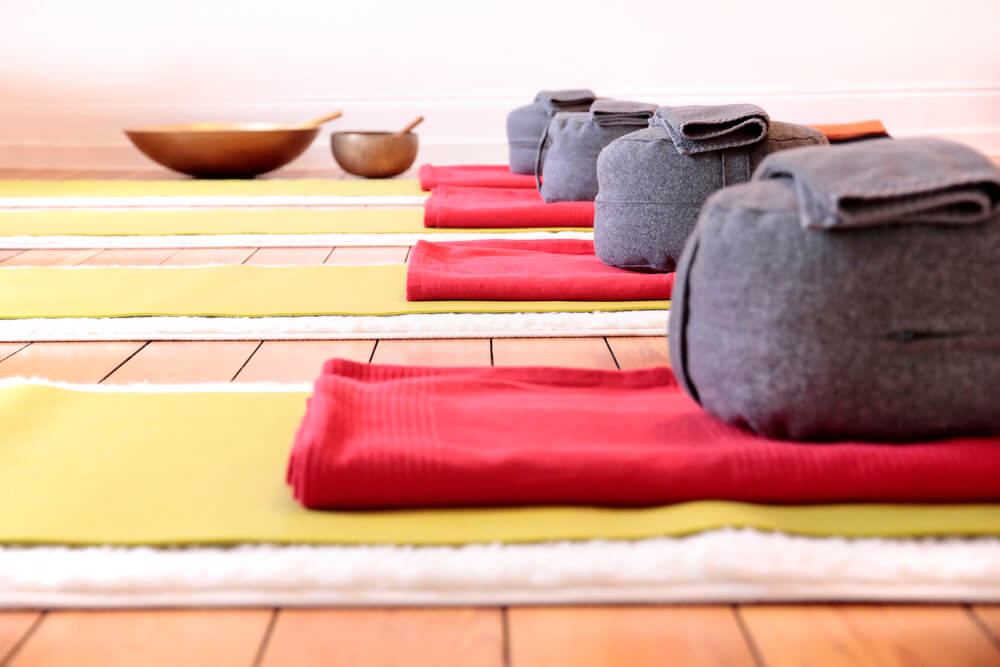In his bestseller On Writing: A Memoir of the Craft, Stephen King wrote “It’s best to have your tools with you. If you don’t, you’re apt to find something you didn’t expect and get discouraged.” And while King was speaking about the writing tools, the same idea applies to yoga tools. Whether it’s bolsters, blocks, straps, balls, or other props, yoga tools serve two purposes. First, they allow those newer to yoga to safely practice poses while their bodies build strength, balance, and flexibility. Ideally, those just beginning their practice can use props to support their bodies. Second, they allow veteran students to deepen their practice with a bit of assistance. Using props correctly can improve the effectiveness of the asanas throughout each class. So what are yoga’s tools of the trade? Let’s take a look at common props and how each can benefit your yoga practice.
Blankets
Blankets are useful during centering, meditation and Savasana (corpse pose) for comfort and warmth, and can be useful as support during kneeling postures. The slightest elevation during seated postures may increase the student’s comfort in the hips, hamstrings and low back while remaining seated or stretching forward. Beyond their use as a support and cushion, this yoga prop can also be a safety measure; for poses such as Crow, which requires strength and balance, placing a blanket in front of the head is an excellent idea should the body tip forward!
Blankets can be folded several times to increase the level of support provided to the body. It’s a good idea to experiment with various blanket heights to determine which folded level is most comfortable for your body and its current practice.
Blocks
This yoga prop can be made from cork or foam. Blocks provide excellent assistance in “bringing the floor up to you” in poses requiring flexibility and strength. For example, in standing forward fold, blocks placed directly in front of the feet reduce the stress on the back and hamstrings as a student bends forward; instead of hands resting on the floor, they can gently rest on the block. Or one can aid extension of the leg in a lunge position by placing hands on the blocks. Instability exists as a core element of yoga as the body increases its ability to find its center and balance. For poses such as Balancing Half Moon, place a block beneath the hand closest to the ground to increase the safety of the posture and encourage the body to focus on developing core strength.
Straps
Many yoga studios provide 6 to 10-foot straps to assist students in poses requiring flexibility and strength. This yoga prop is ideal for stabilizing joints while moving into and holding postures. They are also commonly used to create resistance and/or space within a posture. If you feel as though a particular area of the body feels compressed, belts can help to ease the compression by gently applying positive pressure to release the tension. Most belts used in yoga will have rings or buckles to adjust the size for different postures; it’s important to take the time to figure out the best length for your body to ensure that the pose results in the support, flexibility, and relaxation the pose offers.
Balls
In yoga, balls often serve a dual purpose. They help students build core strength and balance while offering support in more difficult backbend or arm balance poses. Balls may also be used to build strength and increase the difficulty of a pose for more advanced students. For example, a teacher may ask students to hold a ball during a Warrior One posture to increase the work for the arms, shoulders, and core. Studios typically offer several sizes; when choosing a ball prop, select a size that allows you to sit comfortably with your feet flat on the floor.
Bolsters
Perhaps one of the most beloved yoga props, bolsters can serve multiple purposes in one’s practice. First, bolsters aid in the expansion and opening of the body. Gently aligning the bolster with the spine and laying on top can increase the body’s ability to open and release tension. This is an excellent prop to try during corpse pose for an effective, enhanced relaxation technique. Second, bolsters additionally aid the body in safely navigating asanas where alignment is an issue. For a posture such as pigeon, the bolster can be placed directly in front of the body, to rest the torso. This assist allows the hips to remain open while reducing potential stress on the back. Another use for the bolster is in seated postures to raise the hips to knee height decreasing strain on the back and in the pelvis in any seated posture or twist. Bolsters function as a yoga prop to help support the body or provide anatomical neutrality; they can provide the practitioner an avenue to open and more fully release muscular tension.
Yoga is for EVERY BODY regardless of current flexibility, balance, or strength. Yoga props exist as useful tools for both new and experienced students. King’s words ring true: it’s better to use the tools for the support they offer then become discouraged in a particular posture. Yoga props can assist students in mastering postures demanding flexibility and balance as well as aiding students in deepening twists and building strength. Never shy away from placing yoga props around your mat. Remember: this is your practice! Listening to your body and honoring its current levels will help you master the benefits of yoga at your own pace. This is your journey and you should enjoy it.
